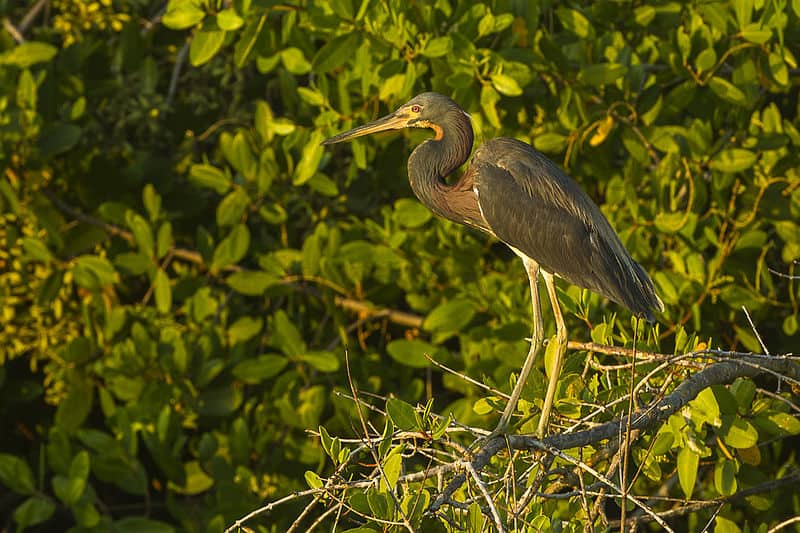
1. Tricolored Heron
Obviously, the recent name-change from “Louisiana heron” to tricolored heron did not sit well with Louisiana bird lovers. Feel free, then, to at least nickname to this gorgeous wader as “Louisiana heron.” Harry Oberholser’s description of this species as “. . . rather small, skinny, snaky-necked heron.” (The Bird Life of Texas, 1974), though fairly accurate, is not exactly flattering either. In truth, the tricolored heron is indeed slender, even as wading birds go; and at about two feet in length it is barely larger than a cattle egret. The combination of darker blue-gray upperparts and white underparts easily distinguishes this species from other herons and egrets.
The tricolored heron is primarily a bird of coastal habitats, with the majority of Louisiana birds confined to the southern 20 percent of the state. In Louisiana it breeds mostly in “pure” colonies, but will occasionally tolerate life in mixed wading bird rookeries. Its favored breeding sites are bald cypress or black mangrove swamps within the Louisiana coastal zone, but occasional breeding colonies have been recorded as far north as the swamps of the Red River near Shreveport and the Ouachita River near Monroe. As is the case with most wading bird species, once the breeding season is finished, tricolored herons often disperse northward and westward, with some stragglers ending up in places as far away as Oklahoma, Arkansas, and southern California. During the winter months, a few birds remain stateside—again, always closely associated with the coasts—but the bulk of the U.S. population heads south into Mexico, Central America, and South America down to northern Brazil.
Tricolored herons are solitary foragers and will vigorously defend individual feeding territories, most often located at the edges of marsh pools, lakes, and swamps. Minnows and other small fishes are primary prey items, but frogs, small crawfish, spiders and insects are also taken.
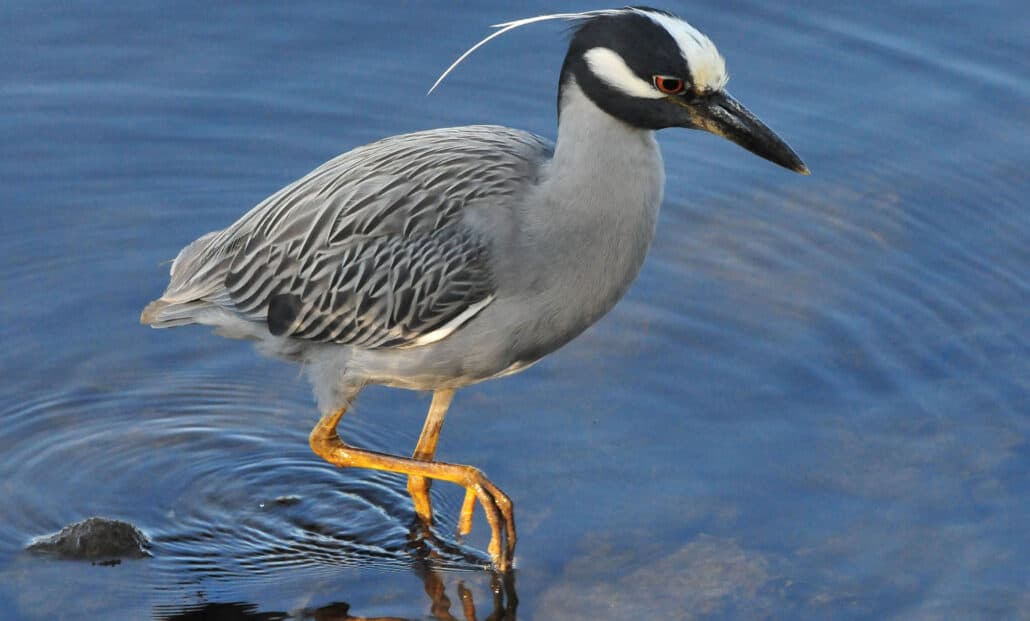
2. Yellow-crowned Night-heron
This husky, short-necked, strong-billed wader is widely distributed statewide throughout Louisiana’s many swampy habitats. Its dark, steel-blue body, combined with black head and bill, red eyes, and strong white cheek patch allow for fairly easy identification. Cajuns refer to it (and its close cousin, the black-crowned night-heron) as “gros-bec” (pron. “grow-Beck”), meaning “big beak,” because of its stout, powerful bill.
In Louisiana yellow-crowned night-herons breed throughout the southern third of the state, and rather generously up the Red River valley from Alexandria to Shreveport, and the Ouachita River valley from Jonesville to Columbia. They rarely stray very far from swamps, where their favorite food item, the crawfish, resides. They have also been known to take frogs, small mollusks, and aquatic insects, but never fish. True to its common name, this species is primarily a nocturnal hunter, preferring to roost in isolated portions of swamps during daylight hours. Thus, the best times to view night-herons are during the early morning and late evening hours. In flight, this species most often remains low. Its wingbeats are moderately quick (for a wading bird) and powerful. Even the voice of this bird seems extra-strong! The call, given mostly in flight, is an emphatic Quak!, occasionally given in a series of several at widely-spaced intervals.
Of all U.S. wading birds, the yellow-crowned night heron displays the most highly neotropical migratory behavior. The bulk of the Louisiana population departs for the warmer climes of Mexico and Panama by the end of September. Rare is the occasion when a yellow-crowned night-heron is found even in coastal Louisiana during the winter months. Birds usually begin returning by mid-March, just in time for peak crawfish season.
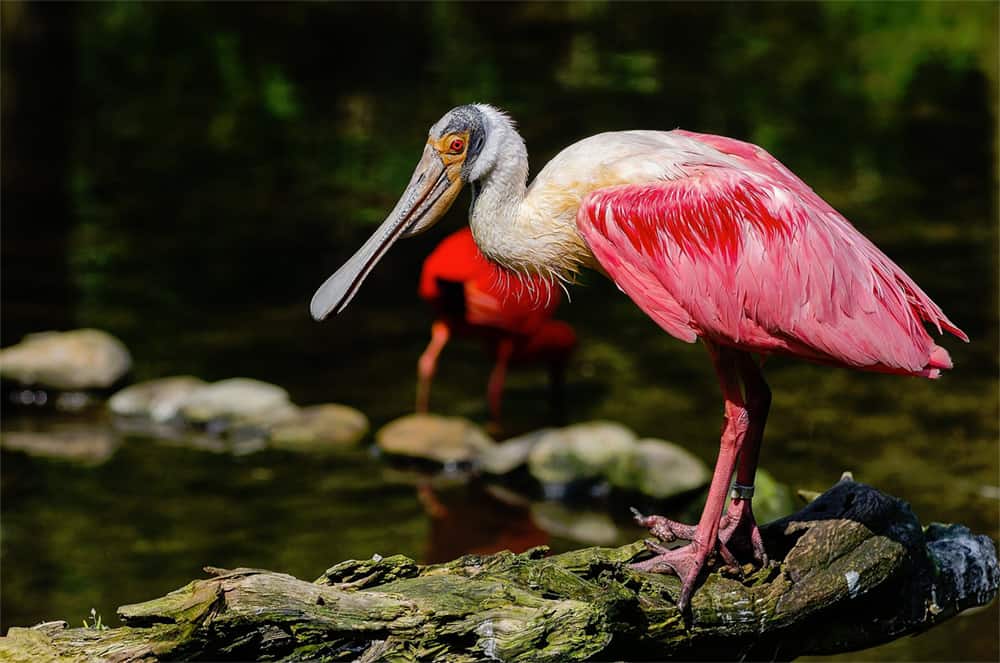
3. Roseate Spoonbill
In his first edition (1955) of Louisiana Birds, George Lowery, Jr., commented, “At one time these magnificent creatures [roseate spoonbills] lent their beauty to much of Louisiana’s marshland, but now only a dozen or so occasionally breed in the extreme southwestern part of the state,” and “From time to time, during the non-breeding season, one or two individuals appear outside of Cameron parish, and fortunate indeed is the person who chances to be on hand to see them. . . following its virtual extinction at the hands of plume hunters.” Fortunately, the situation with the Louisiana roseate spoonbill population is much improved today, with probably thousands of birds breeding throughout much of the state’s coastal zone from Cameron parish all the way east to Breton Sound, below New Orleans.
Surely one of Louisiana’s most magnificent animals, the roseate spoonbill in breeding plumage is unmistakable: massive, pewter-colored, spatulate bill fading to pale mint-green facial and crown skin surrounding golden eyes; rose-pink legs, white back and neck, pastel-pink underparts and wings, with frilly, dark shrimp-pink shoulder plumes; and for good measure, a “hot,” rich golden-yellow tail. Interestingly, young birds are nearly completely white, possessing only the palest pink wash on the wings. It is said that their plumage darkens into more typical colors only after they begin feeding on whole crustaceans as their parents do.
As with the tricolored heron, the roseate spoonbill is primarily a bird of Louisiana’s coastal marshes, and breeds within the protection of nearby swamps, most often in mixed wading bird rookeries. Noteworthy is the fact that in mixed wading bird nesting situations, roseate spoonbills literally rule the roost. Even great egrets make way for the heavier-bodied, more “raw boned” spoonbills. Post-breeding wanderings undertaken during the late summer and fall months occasionally carry birds as far north as Shreveport and Monroe. During the winter months, birds typically hug the coast.
When feeding in water, roseate spoonbills do not scoop up prey with those outsized bills. Instead, they employ a combination of catch-all filter-feeding (much like the northern shoveler, and other “puddle” ducks) as well as plucking of individual items with their super-sensitive bills. Typical prey items include small crustaceans, minnows and other small fishes and aquatic insects, along with some incidental aquatic plant material.
When searching for roseate spoonbills in the marshes of south Louisiana, be sure to periodically scan the skies, as these birds often take flight when commuting between their nesting, foraging, and roosting sites which often lie miles apart.
4. Greater White-fronted Goose
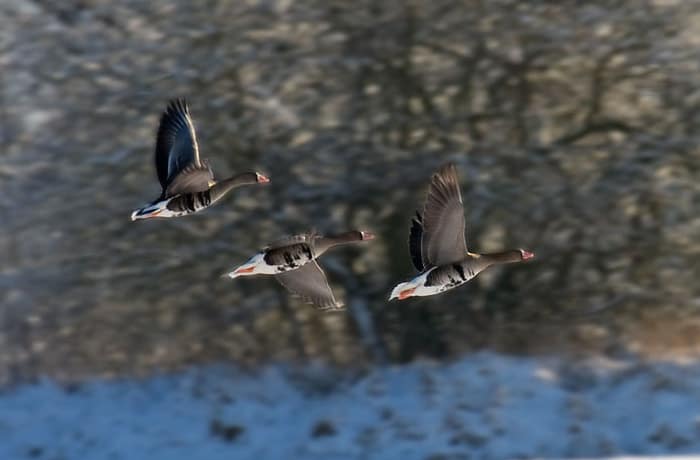
Each year, most of agricultural Louisiana (west of the Mississippi River) serves as prime wintering grounds for hundreds of millions of geese. Of the various species, the greater white-fronted goose stands out as the most beautiful. Nicknamed “speckle-bellies” or simply “specks” by local hunters, due to the dark, broken horizontal barring on their bellies, greater white-fronted geese are quite compact, almost duck-like in structure, compared to the more numerous snow geese with which they congregate. On the bare muddy ground, the brown bodies “specks” tend to blend in with the surroundings, with only the bright white band of feathering encircling the bases of their orange bills standing out. As a group, geese are definitely vocal birds. Greater white-fronted geese possess their own distinct call, which is usually double-noted (occasionally 4-noted) with all notes equally high-pitched, as opposed to that of the snow goose in which the first note is low-pitched and the following notes high pitched. Ultimately, greater white-fronted calls are somewhat more “musical” than those of other geese, and possess a laughing quality to them.
For most of the year North American greater white-fronted geese live and breed within the arctic circle of Greenland, Canada, and the north slope of Alaska. A few also breed a bit further south in western Alaska. Wintering grounds are amazingly disjunct, ranging from the Pacific coasts of southern British Columbia, Washington, and Oregon to the central and upper Gulf Coast of Texas and the southwestern Gulf Coast of Louisiana.
Overwintering greater white-fronted geese generally straggle into Louisiana at the beginning of October, with the bulk of them arriving in November. The majority of them depart Louisiana before mid-March. When traveling mixed in with other goose species, greater white-fronteds most often maintain themselves in family or extended family units rather than mixing in random fashion. On foraging grounds, these units often break away from the main flock. They exhibit a wide array of foraging strategies, including plucking berries and other small fruits, probing in water bottoms for aquatic vegetation and larval insects, feeding on waste grain in agricultural fields, and rooting for young grasses and forbs. It is also said that white-fronteds will pick up floating beech nuts, acorns, and other hard mast which collects at the margins of ponds, lakes, and rivers.
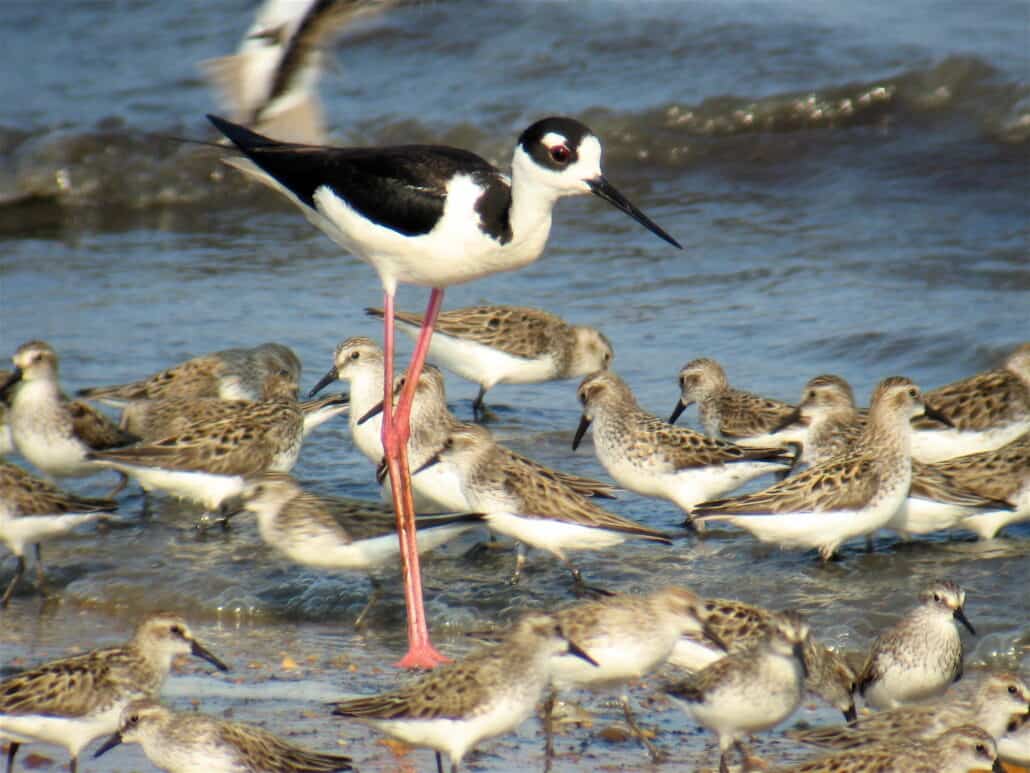
5. Black-necked Stilt
Aptly named, this unusual shorebird possesses a 14-inch body set atop 12-inch legs. Among all of the shorebirds (plovers, sandpipers, and allies) it is the most dapper, possessing dark (black in males, dark brown in females) upperparts and stark white underparts. Add to this a long, needle-like black bill and carmine-red legs, and you’ve got a memorable bird.
In Louisiana, the black-necked stilt has expanded its range in direct proportion to the expansion of rice farming. Thirty-five years ago, the stilt population in Louisiana was moderate, and mostly confined to the marshes of the state’s coastal zone. Today, black-necked stilts are common sights both in the marshes and the ricefields. Nesting currently occurs as far north as the ricefields of Natchitoches (just south of Shreveport), East and West Carroll, and Morehouse (north of Monroe) parishes. Nesting stilts will vigorously defend their territories with much wing display (similar to that of killdeers), hopping about or flying in low tight circles around any interloper, and yelping/barking out vocalizations all the while. They also commonly utter their “yip-yip-yip!” vocalizations in regular flight. In flight, the extra-long legs are held out horizontally, as is the outstretched neck, creating a unique flight profile.
Non-breeding birds also prefer marshes and ricefields, but are also known to visit other watery places such as the shorelines of reservoirs, sewerage ponds, and other artificial impoundments, usually in pairs or in very small numbers. Black-necked stilts feed in mixed flocks, especially with long-legged species such as greater yellowlegs and American avocet. Like the yellowlegs, stilts delicately pick their prey from the water and associated vegetation. Typical prey items include insects (aquatic and terrestrial), mosquito larvae, and snails.
During winter the Louisiana stilt population is greatly augmented by individuals migrating in from the Great Basin and lower Midwest. The majority of these birds overwinter in the marshes south of Interstate-10.
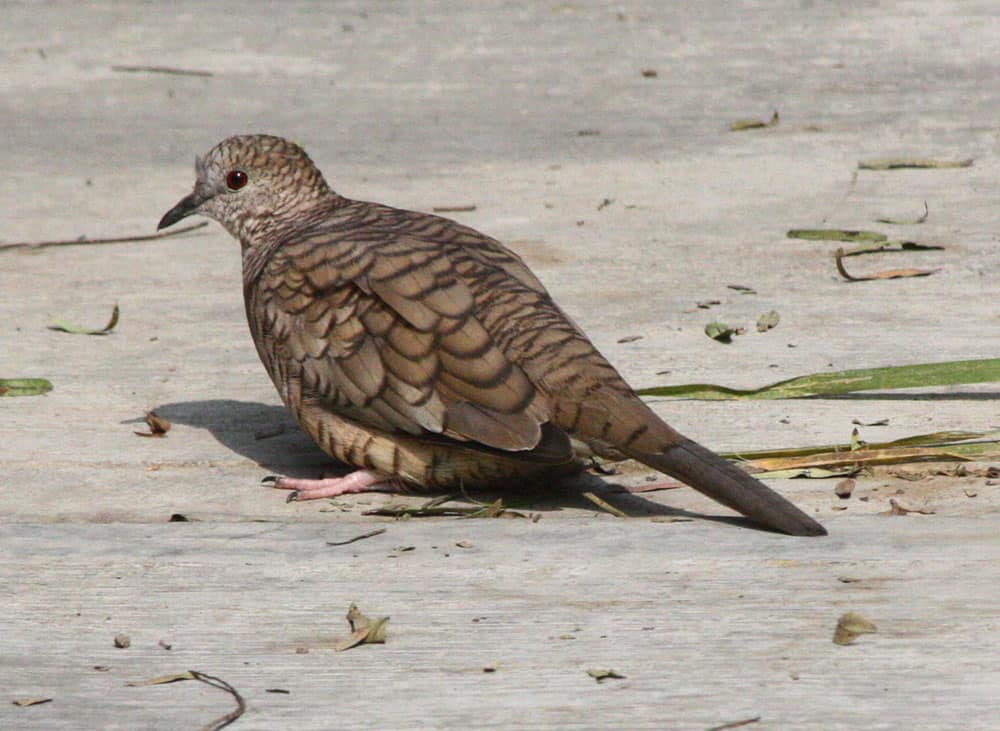
6. Inca Dove
Originally, this small beautiful dove’s range was limited to Central America and Mexico, but along with others such as the white-winged dove, fulvous whistling-duck, and now the black-bellied whistling-duck, it has steadily crept northward, reaching San Antonio and Austin by the late 19th century, and Louisiana by 1935. It has only recently, however, become a firmly established year round resident throughout southwestern Louisiana, where it prefers living around human habitations. The Inca dove has been slow to colonize other parts of the state but has nevertheless made frequent appearances throughout much of Louisiana.
The Inca dove is about 25% smaller than the mourning dove. Like the morning dove, it possesses a relatively long tail, replete with white-tipped outer tail feathers. Unlike mourning doves, Inca doves are pale birds, possessing putty-gray to sandy-brown bodies. Moreover, the tips of most of the feathers are marked with dark crescents, giving the bird a characteristically “scaly” look. During its brief, low, rapid/jerky flights, the bright rufous coloration of its wing primaries is prominently displayed.
Actually, the only other U.S. dove with which the Inca dove might be confused is the common ground dove, a now-uncommon gulf coastal species which is mostly confined to agricultural areas and dusty roads. Compared with Inca doves, common ground doves possess shorter tails and “scaling” limited to the wing plumage only. Otherwise, they are quite similar in appearance and “near-ground” lifestyles.
In Louisiana Inca doves occur in small groups of two to five birds, often perched on low trees, fences, and more occasionally, on utility lines. Look for them on the ground as well, especially around vegetable gardens, poultry and livestock yards, and other bare-ground habitats. During spring and summer its distinctive “cooing” vocalization, a somewhat emphatic, two-part “ooh-who!” uttered at close intervals, is given at most any time of the day.
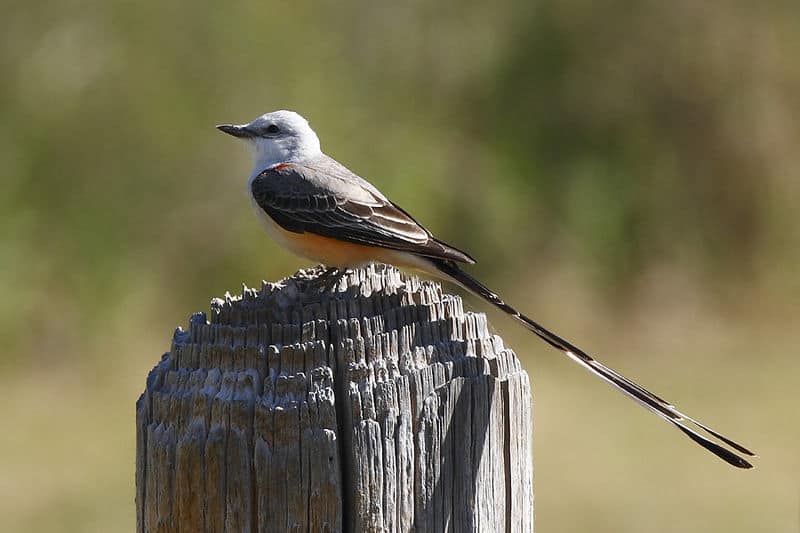
7. Scissor-tailed Flycatcher
Like the Inca dove, the scissor-tailed flycatcher has gradually moved into Louisiana from the southwest. In the first edition (1955) of Louisiana Birds, George Lowery, Jr., characterized this species as “. . . not frequently seen in Louisiana, except in the southwestern section, where it is fairly regular in migration, and in northwestern Louisiana, where it is not uncommon during the summer.” Today, scissor-tailed flycatchers breed throughout the entire western half and extreme northern parts of the state, and spring and fall sightings regularly occur throughout the coastal zone.
With its pearly-gray body, salmon-pink sides, and exaggeratedly long tail, the scissor-tailed flycatcher is easily identifiable. Be on the lookout, however, for the similar-looking fork-tailed flycatcher, a very rare tropical species which has occurred throughout the eastern U.S., especially during the fall months. That species differs from the scissor-tailed in having, among other things, a black-capped head.
To witness the graceful elegance with which scissor-tailed flycatcher carry on their day-to-day duties is one of the great thrills of Louisiana bird watching. More than anything else, it is the combination of a 9-inch, completely forked tail attached to a body about the size of an eastern bluebird that results in a flight style which is difficult to describe in words. Should you be fortunate enough to witness the courtship display of male scissor-tailed flycatchers during the spring and early summer months, you’ll see the marvel of flight ratcheted up several notches. Texas ornithologist Harry Oberholser describes it thusly: “Mounting one-hundred feet in the air, he plunges downward, then alternately bursts upward, accompanying these mid-air zigzags with high-pitched cackling; in the final descent he often appears to somersault backward several times.”
Scissor-tailed flycatchers are open-country birds, and greatly prefer grasslands over farmlands. Thus, pastures and prairies are the best places to look for them. As you travel through appropriate habitat, be sure to peruse not only utility lines but also fences, both of which these birds frequently use as hunting and resting perches.

8. White-eyed Vireo
This species is by far the most common vireo in Louisiana. It is ubiquitously distributed within just about every woodland in Louisiana (including small woodlots, urban/suburban forests, and brushy agricultural hedgerows), where it prefers more densely vegetated forest edges and interior gaps. White-eyed vireos are most abundant throughout the state during spring and fall migration periods, when transient birds from other regions of its eastern U.S. range supplement the native population. It is also extremely common as a breeder during the summer months, and a substantial number of birds tend to linger in Louisiana over the winter, especially in the southern half of the state.
One of our most colorful vireos, the white-eyed possesses olive upperparts, whitish underparts amply washed with yellow on the sides and flanks, a gray nape and neck, two prominent white wingbars on dark wings, and characteristic white-irises surrounding with bright yellow “spectacles” (i.e. bold yellow line from the base of the upper mandible back through the lores and curling around to encompass the eyes). Young birds lack the white-irises; and the plumage-worn young birds which appear at the end of the summer possess much grayer upperparts, reduced wingbars, only a hint of yellow wash on the sides, and white (instead of yellow) spectacles, causing them to look more like Bell’s vireos. Thus, extra caution should be exercised in differentiating young white-eyed vireos from Bell’s vireos in August and September, the latter of which are rare migrants through the state during that time of the year.
Due to their cryptic coloration and stealthy/lethargic behavior, vireos are much more often heard than seen. This is certainly the case with the white-eyed, whose complex, mechanical CHIP-fell-off-thewhiteoak-the-redoak call is heard almost ad nauseum throughout the spring and summer months. Indeed, even during the hottest parts (mid-day through early afternoon) of those days, when all other birds are silent, the white-eyed vireo continues to sing away, driving all of its non-vireo listeners to the brink of slumber from the monotonous melody combined with the heat of the day.
To actually spot and study adult white-eyed vireos, much patience is required. Listen for the call, track it down to a general location, then settle back and wait for the occasional hop up or down from twig to twig which white-eyeds employ during foraging sessions. Vireos tend to spend much more time concealed within foliage, carefully peering under leaves for adult and larval insects than they do moving about in a frenetic search, as most warblers do.
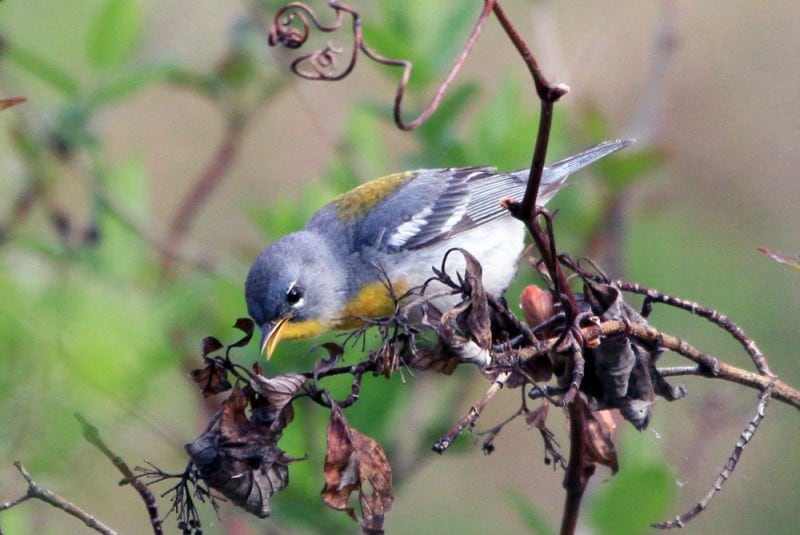
9. Northern Parula
No sound better conjures a typical spring or early summer day in the bottomland hardwoods and swamp edges of Louisiana than does the elegant ascending twitter of the northern parula’s breeding song. Amply distributed within these moist, deciduous forest habitats, this tiny warbler is nothing less than a living jewel. Northern parulas are among the first neotropical migrants to arrive back in the U.S. each spring, normally showing up by the first weekend in March, and staying on through October in Louisiana.
At only 4 1/2 inches in length, the northern parula is among the smallest of our U.S. warblers. It possesses steel-blue upperparts, punctuated by a generous olive patch in the middle of the back. Likewise, its immaculate-white underparts are marked with an interesting crescent-shaped mix of burnt-orange and yellow coloration on the breast. Northern parulas are also conspicuously marked with two bright white wingbars, white inner webs toward the tips of its otherwise blue outer tail feathers, and two bright white crescents directly above and below each eye.
Like the vireos, the northern parula is much more often heard than seen in Louisiana, as its favored nesting and foraging habitat is high up within the crowns of live oak trees. Moreover, it most often builds its tiny nest hidden within festoons of Spanish moss associated with these oaks. Still, northern parulas may be comfortably viewed throughout many wooded habitats during spring and fall migration, as well as during the month of June, when newly fledged young (usually with their parents hot on their trails) tend to travel down to lower levels in search of food or to simply explore new places.
It’s always easiest to at least initially detect northern parulas by listening for their trademark songs, which consist of a drawn out series high-pitched twitters accompanied by a peculiar ascending quality, like that of a glass being filled with water.

10. Yellow-breasted Chat
By all respects it seems strange that the yellow-breasted chat should be classed within the wood warbler family (Parulidae). At 7 1/2 inches in length, it is grossly larger than all other warblers. Combine this with its briar patch-dwelling habits, its predilection for wild fruits, its thick, blunt bill, and bizarre voice, and a considerable case mounts for its exclusion from the U.S. warbler group
The yellow-breasted chat is a dedicated neotropical migrant, with the vast majority of the U.S. population departing for the tropics by the end of September. Precious few birds remain stateside during the winter, and those which do remain well-protected, concealed within dense, evergreen, Japanese honeysuckle thickets along Louisiana’s coastal zone. In the spring this species takes its time about returning northward, with first arrivals generally not detected until mid-April.
As the common name implies, yellow-breasted chats possess rich yellow breasts combined with olive upperparts and white bellies. Chat faces are quite distinctive, replete with prominent white “spectacles” and malar (“moustache”) lines, black lores and thick black bill.
Undoubtedly, the strangest thing about the yellow-breasted chat is the male’s breeding song, which is endlessly repeated, often through the night, from mid-spring through mid-summer. Texas ornithologist Harry Oberholser describes it as “one or two harsh notes followed by clear whistling calls, cackles, chuckles, rattles, squawks, and pop; these are on the same or different pitches and intermingled in almost endless variety.” In the book Louisiana Birds, George Lowery, Jr., resorted to borrowing Edward Forbush’s phonetic description of the chat’s song: c-r-r-r-r-r-r, whrr, that’s it, chee, quack, cluck, yit-yit-yit, now hit it, t-r-r-r-r, wher, caw, caw, cut, cut, tea-boy, who, who, mew, mew. . .
With a voice like that, the fact that this species is quite shy and retiring is almost mind-boggling to consider. Rare is the occasion when a yellow-breasted chat will emerge very far above the dense thickets that it so loves. By far the best time to look for chats is just after dawn, when they often fly up to utility lines or fences to allow the rays of the rising sun to dry the dew from their plumage.


